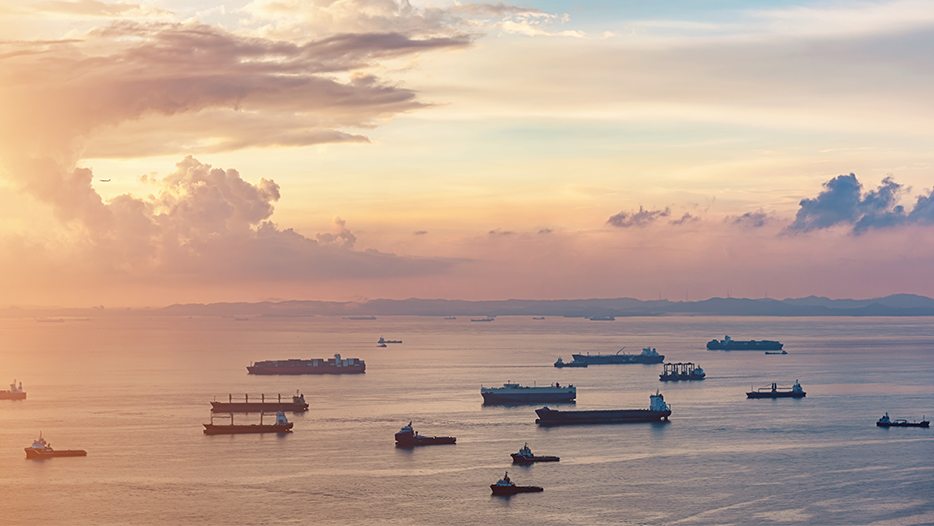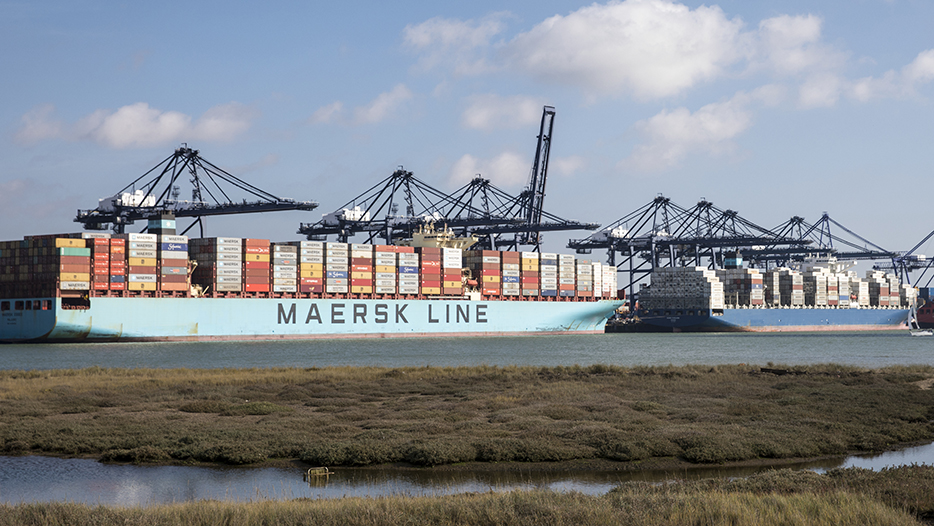
Are calmer waters ahead for UK shippers after freight rate surge?
The global oceans have become treacherous for UK importers and exporters. The fallout from the coronavirus pandemic has caused the cost of moving cargo by ship between Asia and Europe to swell in recent months as disruption to services limits equipment and capacity, rocking international supply chains.
To help your company navigate these rough seas, we spoke to the chief executive of EV Cargo Global Forwarding on what he sees coming next and how businesses can ride out the storm.
UK shippers such as manufacturers, retailers and wholesalers have seen the cost of containerised sea freight imports jump in recent months, with the price of moving a container from China to Europe skyrocketing up to 600% since before the onset of the pandemic. The hike in expense results from disruption to the shipping industry caused directly and indirectly by the pandemic, putting space and equipment at a premium.
If that wasn't already enough to deal with, congestion at some of the UK's major container ports has further added to British shippers' burdens. All of this has placed pressure on UK supply chains and pushed what has been treated sometimes in the past as purely a procurement exercise to the top of the agenda of senior executives.
While the worst may have passed, and the extreme level of rate and market disruption seen last year should not extend to the same degree during 2021, there is no sign of rates falling back in the immediate to medium term. However, there may be steps you can take to make yourself more resilient to any market turbulence, according to Clyde Buntrock, the chief executive officer of EV Cargo Global Forwarding, a leading UK-based global freight forwarder with wholly-owned subsidiaries across Europe, the Middle East, Asia and Africa and a further 20 individual country-based investments across the world.
Mapping the seas
To chart a course forward, taking on board current market conditions is essential. Buntrock said there were three main dynamics that had caused prices to spike. Firstly, the pandemic has thrown the shipping industry's broadly predictable sequence of peak and low seasons into disarray by creating abnormal drops and subsequent surges in freight demand as national lockdowns have been imposed and eased, especially in North America and Europe. Critically, this change in the equilibrium has meant shipping containers out of position from where they would typically be required.
"For example, you'll always have a peak before the Chinese New Year as capacity fills up ahead of China's factories shutting down for the holiday, and there's another surge toward the later summer months as things build toward Christmas. What the pandemic has done is to completely throw that into disarray and create new peaks with the closing and reopening of non-essential retail," Buntrock said.
Secondly, lockdowns have caused a shift in consumer spending away from the service industry and into hard consumer goods, especially those bought online.

"In Europe, a significant percentage of disposable income gets spent on holidays and eating out, but with lockdowns, that has been impossible. So there's been an enormous rise in consumerism. That has been borne out through the volumes we have seen in our pure-play and online customer sector, where we've had to handle a 25%-40% spike in cargo volumes year-on-year. That's just a reflection of the rise in online shopping and discretionary spending. If we look across our customer base, all of those with a mature online offering have traded exceptionally well throughout this period."
Then, specifically for the UK, an additional issue has been significant port congestion caused by restrictions inherent with the pandemic and ongoing infrastructure and technology issues. That has meant some freight carriers have been unable to unload all their containers due to a lack of quayside space and slow operations, causing them to divert boxes to other destinations, sometimes outside of the UK, and discharging them there. Customers have then had to arrange the repatriation of the containers.
"That congestion has meant from a European perspective the UK has become less attractive to move containers to as a direct port of call. In recent months, you've seen an increasing unwillingness of carriers to accept booked cargo for the UK, and carriers have cut allocations," Buntrock said. An indicator of this can be seen through the disparity between the UK's and continental Europe's "Freight All Kinds" rates, which applies the same price to different cargo types when mixed in one container. Right now, the UK is anything between $1,000-$2,000 more expensive.
All this means that space and capacity have been at a premium, turning the container shipping world into a suppliers' market, from what had been a buyers' market for many years with a run of prolonged low rate levels.
With price rises beginning in earnest in November, by January, shippers were reported as being quoted up to $14,000 to move a 40-foot long container from China to the UK, compared with $2,000-$3,000 before the pandemic. To add insult to injury, even those sky-high prices weren't ensuring good service due to the uncertainty in sailings and space.
"We're aware of situations in the market where a large cargo mover may have been quoted by a competitor $12,000 to move a container with no guarantee that it's even going to get on the ship," Buntrock said.
And it's not just the UK. Both the Asia-to-Europe trade, which accounts for about 70% of EV Cargo Global Forwarding's business, and the Asia-to-US/transpacific trade have seen very similar stories regarding rising rates, capacity constraints, pandemic disruption, and an increase in consumerism.
What's over the horizon?
Buntrock is confident that we're past the absolute peak in prices. A significant reason for that is the end of the Chinese New Year last month. With that, the shipping industry has moved from a traditional peak season in demand to a quieter period, typically known as a "slack" season. Still, he thinks the effect of the end of the Chinese New Year this time will be short-lived and we won't see a sudden correction in prices.
"Carriers will be unwilling to relax them too much as they have had a taste of higher rates, so I don't think they're going to fall away dramatically any time soon. Also, we still see significant port congestion around the world, notably West Coast and now East Coast North America, with a surge in trans-pacific volumes between Asia and the USA, where ships have been unable to berth at port in some cases for up to 10 days.
"Much of this is caused by continued container imbalances where more containers are coming into port than departing, compromising quay space and slowing down operations. The same is true in the UK of Felixstowe, Southampton, and even now Liverpool, after carriers tried to bypass the congested southern ports in favour of diverting north. It is also as relevant in Europe at ports such as Antwerp, Rotterdam and Hamburg. All of these ports are seeing higher container imbalances so far in 2021 as compared to 2020.
"There is a lot of uncertainty in the market and big questions around what the actual true market rate is and where it is going to settle. Ultimately, the best rate is one that holds, has the service you need in terms of transit time and schedule reliability, and critically actually gets on the ship. It depends on how much you're buying as to what rate you can get, but for the most part, customers are choosing to hold out, moving to monthly or quarterly rate deals rather than fix in at what is highly likely the top of the market in a 12-month window."
"One thing for sure is that carriers have learnt much through the pandemic in terms of how to manage capacity and yield at box, vessel and rotation. Even with no major disruptive factors in 2021 like those we saw in 2020, carriers will be focusing on box yield with improved clarity through process and systems, which will keep rates higher than recent years."
Beyond the current demand cycle, the port congestion in the UK has caused speculation that some carriers may seek to avoid the country as a direct port call in the future. Instead, they could opt to route cargo from Asia to continental Europe before sending it on to UK ports in smaller ships called "feeder vessels".
For UK-based companies, the extra stop off in a container's journey could mean longer transit times and less reliable supply chains, as well as increased complexity and work to coordinate the extra moving parts and handoffs, Buntrock said. It will also increase anxiety for supply chain managers. "You're going to want to make sure that box is making its onward leg. It will be a big change for quite a few UK companies, most especially the mid-market if that happens," he said.
Investec economist Sandra Horsfield says:
"How world trade evolves is typically related to global gross domestic product (GDP) growth, but with greater amplitude of swings: fast output growth globally tends to lead to even more rapid growth in world trade, and vice versa. With many services being unavailable in the pandemic, the demand for goods has held up better relative to GDP than usual. The resulting support to freight demand at a time of supply disruptions to shipping has sharply increased prices."
"Looking ahead, we expect rapid global economic growth this year and next of 6.5% and 5.2%, respectively, as the vaccine rollout should allow pent-up household savings to unleash demand. As a mirror image to what happened in the pandemic-induced slump, services demand should outperform that for goods. Therefore global trade may surge less strongly than such impressive GDP growth alone would typically suggest. That, coupled with an end to supply disruptions in shipping, looks set to lead freight rates down again in time. Still, not all excess savings will be spent on services, so the demand for freight is likely to stay historically robust."
To hear more from our economists, please sign up for our webinar Q&As >
Trim your sails
With the freight industry crystallising risks for businesses across the supply chain, senior executives have moved in recent years to run a tight ship. Supply chains have been pushed up the C-suite agenda and now regularly feature among the top five issues for many management boards, according to Paul Rablen, a logistics expert and a director in Investec's Growth and Leveraged Finance business.
"Before, it was one of those things that you just expected to happen in the background – a hygiene factor. It wasn't a strategic issue because you had a reasonably benign environment and goods were moved easily and predictably. Whereas nowadays, it's not quite the same. People realise that their businesses can't exist without moving things from A to B," Rablen said.
Buntrock agreed that there's a desire to de-risk supply chains as much as possible. The recent price increases and service issues in the shipping industry have shone a spotlight on how dependent satisfying the rising demand for consumer goods in northern Europe and North America is on manufacturing in China.
"If your strategy is a low-price customer offering, your entire business model is likely based on buying your goods in Asia, and most likely China. Suppose your margins suddenly disappear, and because of the unreliability of your supply route, you can't even commit to when you're going to get products in. In that case, your business model is really at risk," Buntrock said.
In response, companies are looking much more closely at who they're working with, how they're structuring the supply chain and the control they exercise, and simplifying things, which is probably the best way to reduce risk.
"They are increasingly evaluating where goods are sourced. We've seen an increase in sourcing out of Eastern Europe and Turkey. Dual-sourcing has been around for very many years. For example, importers can source their initial allocation from Asia and then replenish the same products from countries such as Turkey for the speed of response. We have already seen this increase in recent months, and we think that's going to accelerate further," Buntrock said.
But while there's some increase in dual-sourcing and near-sourcing, Buntrock doesn't see any significant moves by companies to shift manufacturing away from China. "The world can't do without China," he said.
Sailing in a storm
But in terms of taking more immediate steps to mitigate the current turbulence, Buntrock gave shippers options. One alternative to going by ship, albeit a more expensive one, is air freight, he said.
"We have seen some cargo migrate to air freight to get around the recent shipping problems, or use a combination of air and sea, but only for the types of goods that would suit that method of transport. But capacity has been hit in air freight too – around 50% of air cargo capacity is delivered under passengers' feet in commercial liners. So fewer planes in the sky mean major capacity issues and air freight rates have also spiked as a result.

"Also, we've also had some customers try to avoid the congestion in some of the major container ports in the UK by shipping into continental Europe first and then bringing it over via road freight typically over the short straights to Dover and other Channel routes."
But ultimately, securing the right service for your company depends on how you go about procuring freight, Buntrock said. Anyone can go to the market and get a cheap rate. But a cheap rate is not worth anything unless you get the service and your goods get on a ship and moves. "In many instances, you don't know if the box is shifting until it's actually on the water," he said.
Rather than focusing solely on price, shippers should try to work in a consultative and long-term manner with their service providers. Shippers should try and find providers that will truly act in their best interests by helping them to fully understand the market dynamics and the range of options available to take advantage of those conditions through the season.
"For me, there's a big difference between a freight provider and a supply-chain provider. We would always say freight is something we do, but we try and concern ourselves with the product that the customer needs to move and the service that needs to come with that," Buntrock said.
For the company doing the importing or exporting, that may require a change in mindset. Buntrock said shippers need to integrate supply-chain thinking with classical procurement thinking, where they both work hand-in-hand. Rather than just going for the best rate, decisions are arrived at in the best interests of the overall business over time.
"What we've always tried to do is build long-lasting relationships with our carrier suppliers and then back those into agreements with customers on a very transparent basis. For example, the carrier will know who the customer is and that we're the intermediary. The customer provides us with a forecast of what they want to ship and when, and we ask the carrier to honour that forecast. It's at quite a granular level – it's the number of containers per week, per port, and with an equipment split. That level of detail is quite unusual in the market.
"A lot of large cargo movers will just go to the market and say, `We've got 10,000 containers to move next year – give me a rate.' They're not going to tell the carrier when they're going to move it, what ports they're going to move it from, or any real transparency, which means that planning is almost impossible. We try to go to a much deeper level and find that breeds confidence from our carrier partners. In the complicated world of international supply chains, things will invariably go wrong - production issues, bad weather, strikes, even global pandemics. But the more granular your planning and the more collaborative your stakeholders are, risks can be reduced.
"Carriers generally know it's a recurring annual deal, so they see the shipper is not just going to take advantage of the slack season to get a low rate. There's a rate there that looks through both the slack season and the peak season. It's generally not either the highest or lowest rate. You could always go to the market and get a lower rate, but it is a rate that is competitive and can be reliably serviced throughout that period.
"You can keep going back to the market and pushing, but you could be jeopardising service. It's a false economy. Hundreds or even thousands of dollars extra on a freight rate to arrive on time in full is better than half a million dollars of marked-down products because you missed the season and can't sell them."
As well as choosing the right approach, another consideration is the timing of freight negotiations between shippers and providers, Buntrock said. "It's never a good idea to lock in at the top of a market."
So while the shipping industry could still face challenges over the coming months, relief could be on the horizon for UK cargo shippers. The mixture of surging demand, logistical bottlenecks and equipment shortages should hopefully start to ease over time, lessening the pressure on capacity and rates. Regardless, though, the importance of supply chains will remain high on the agenda of management boards as the long-term currents of global trade change. In these seas, a navigator has never been more critical.
Find out more about our wide range of capital, advice and treasury and risk solutions to help your business grow. Please complete the form below, or call or email us.
Browse articles in
Please note: the content on this page is provided for information purposes only and should not be construed as an offer, or a solicitation of an offer, to buy or sell financial instruments. This content does not constitute a personal recommendation and is not investment advice.


